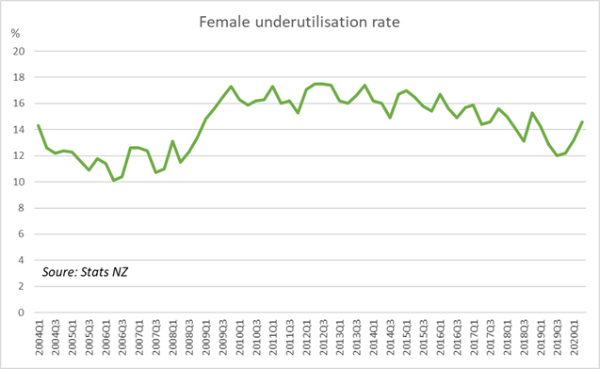90% Of The Drop In Kiwi Employment Were Women, But Covid Creates Confusion

- Women have historically fared well in times of war and crisis. But Covid-19 has induced a recession like no other. And women are especially vulnerable.
- In the June quarter, 11,000 Kiwis lost their jobs. And 10,000 of them were women. That’s 90%! While we don’t quite believe the numbers, the shock to women was especially harsh.
- We had forecast the disproportionate impact on women from the Covid-19 induced lockdown. There are simply more women in the service related jobs that Covid impacted the most (See here).
Women have historically fared well in times of war and crisis. During the Second World War, there was a dramatic rise in female employment. As men were called to arms, women were called to the factories. There was an increasing demand for female labour to fill job vacancies left by servicemen. In September 1939, the female labour force was estimated at 180,000. Typical increases in 4 years would have seen the force expand by around 5k. But by December 1943, 228,000 women were employed. And again, female labour was hot in demand during the economic recovery period in the 1990s. The recovery phase following the ‘Rogernomic’ era was tentative, and employers sought flexible workforces. With part-time employment a popular option among women, female employment was barely disrupted.
In fact, female employment was left relatively unscathed during the extensive restructuring in the 1970s and 1980s. And it all boiled down to the positioning of women in the labour market. The industries targeted by (Finance Minister) Roger’s reforms were those heavily male-dominated, manufacturing in particular. Similarly, with the GFC, the financial sector was hardest hit, with redundancies left, right and centre. As a predominately male occupation the hit to employment in the recession that followed was softer for women than men.
But the Covid-19 pandemic has created a recession like no other. NZ was under level 4 lockdown for 34 days and 50 days including level 3. With stay-at-home orders issued, businesses shut up shop. The service industry will likely bear the brunt of the nationwide lockdown. And for the same reasons male employment was hardest hit in previous crises, women are especially vulnerable this time around. Because over 60% of sales workers and over 70% of hospitality workers are female (See more here). Today’s June quarter labour market statistics reflect how the lockdown has disproportionately impacted the workforce.

The female underutilisation rate shot to 14.9%, up from 12.7% (+29,000 women in the quarter), and the unemployment rate rose to 4.4% (+1,000 more women unemployed). The numbers for men were more modest. More striking is the gender breakdown of those no longer employed. Employment fell 0.4% over the period, which equated to an 11,000 fewer people in paid employment. And of those 11,000, 10,000 were women. That’s 90%! While we don’t quite believe the numbers, the shot to women was bullseye.
Since lockdown, the hospitality sector has bounced back. Our proprietary transactional data show spending at restaurants, cafes and bars have lifted from lockdown lows. But social distancing early on meant it was costly to maintain a full staff rotation. Despite now at level 1, some firms may make the shift to a smaller workforce permanent. It may take a while for female employment to return to pre-Covid levels.

Because of the fiscal support to date, the numbers could have been worse (even the actual numbers). The wage subsidy has helped many businesses remain in business, and employees remain employed. But for others, the subsidy pay-out may just be delaying the inevitable. Once the lifeline comes to an end, job losses will surely mount. And there’ll (still) be a pinkish hue to the numbers,
The war years were a turning point for women in the workforce. More women joined and more women moved into jobs traditionally carried out by men. The current recession may offer another opportunity to address the gender composition of the labour force. It may be that some women are looking to re-train to be re-deployed into other industries. The door to the manufacturing and construction industries is open. And these are sectors where women are largely underrepresented. The Government’s $1.6mil trade and apprenticeship training package could be used to encourage more women to pick up the tools. As they say, don’t waste a crisis.


 Gordon Campbell: On The Government’s Stubborn Refusal To Invest For Growth
Gordon Campbell: On The Government’s Stubborn Refusal To Invest For Growth Green Party: Just Six Government MPs Needed To Pass Unlawful Occupation Of Palestine Sanctions Bill
Green Party: Just Six Government MPs Needed To Pass Unlawful Occupation Of Palestine Sanctions Bill Ngāti Manuhiri Settlement Trust: Iwi Welcomes Progress On Northland Expressway
Ngāti Manuhiri Settlement Trust: Iwi Welcomes Progress On Northland Expressway Kick Back: Urgent Review Of MSD Needed To Prevent More Rangatahi Sleeping Rough
Kick Back: Urgent Review Of MSD Needed To Prevent More Rangatahi Sleeping Rough Te Pūtahitanga o Te Waipounamu: Government Hellbent On Ignoring Evidence On Impact Of Social Investment For Most Vulnerable Whānau
Te Pūtahitanga o Te Waipounamu: Government Hellbent On Ignoring Evidence On Impact Of Social Investment For Most Vulnerable Whānau Rangahau Aotearoa Research NZ: One In Two New Zealanders Are Affected By The Cost Of Living Crisis
Rangahau Aotearoa Research NZ: One In Two New Zealanders Are Affected By The Cost Of Living Crisis Greenpeace: Greenpeace Seamounts Expedition Sets Off To Uncover Secrets Of The Deep
Greenpeace: Greenpeace Seamounts Expedition Sets Off To Uncover Secrets Of The Deep


